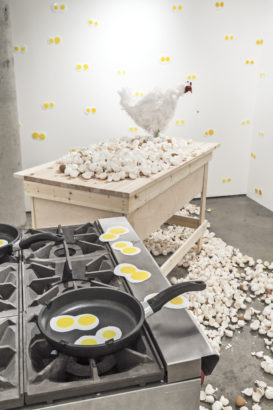Elizabeth Diggon Interviews Rita McKeough
28 January 2015
Elizabeth Diggon: In a number of ways, tender seems like a counterpart to, or extension on, The Lion’s Share. Could you speak a bit about how tender emerged out of, or was influenced by that installation?
Rita McKeough: [The Lion’s Share] was really about making the body of the animal present. The tongues coming out of the milk were about the cow’s body being present, and the tenderness of maybe a kiss or a lick on the cheek. The chicken was trying to lay the eggs to keep the orders up in the kitchen – she was exhausted and you just saw the workload and the stress.
The piece [The Lion’s Share] is about looking at the source of the food and also at what happens at the end of the production process. When I see a hot dog, I always think of everything that came before it. The slaughter, all the scraps that they gather, and then you have a hot dog on your plate. I didn’t just want to talk about eating meat, I wanted to talk about the industrialization of food production. In The Lion’s Share, I used a lot of mechanical elements. The noise of the motors was really important to me – that focus on the factory and the industry. Then there are all the hot dogs that are left in the buffet table, some of them have been pierced, some of them fell off, you think of the ones in your kitchen, in the garbage. To me the hot dogs represent two things simultaneously – the body of the animal and the process of food production. You bring both things together, and you see that you can’t separate them. With a cow, you can separate them, with a steak you can separate them, but with a hot dog you can’t. You see the factory, you see the process, you see everything, and you can still see the flesh.
So [with tender] I really wanted to offer the same kind of tenderness and empathy and love to the hot dogs that I would to the body of a cow. The idea of a rescue is really interesting to me, because it’s like the hot dog might escape on its own, or some sympathetic person might grab it off the counter and run with it, or it might sneak away and hear about the shelter and come to the hospital. It’s an escape from the process of production. So the hot dogs get to the hospital, and it’s good to think of, you know, how do you undo something like that? By feeling that pain, and by sharing with empathy, there is the possibility of change. For me the hospital is about that, it’s about offering a place of safety. In the statement we say that rest and rehabilitation is how we heal. We desire for [the hot dogs] to be healed and, we imagine what healing would mean. In the best case, the hot dog would jump out of bed, be a cow again, and run out into the prairie and live happily and unharmed for the rest of its life eating prairie grass. That’s the dream. The projection of the cows is there so that dream, or the perfect ending of the story would be to resuscitate the hot dog back to the dream life of a cow; not the one that’s in the feedlot, not the one that’s in the slaughterhouse, but the one that’s out on the prairie, grazing comfortably, in the sun, unharmed.
ED: As you mention that, I’m struck by the contrast between the projection of the cows, who are so beautiful and so lovingly filmed; and the hot dogs who look almost anaemic and wan in their hospital beds. Indeed, this installation, but also works like The Lion’s Share, compels me to think about reciprocity – for instance, reciprocity between a community and its surroundings, or a community and its food. How do you think notions of reciprocity might impact how we eat?
RM: I think it’s a really good word to use. There’s a hierarchy. If I was a meat eater – and I’m not – but if I was, and I really liked steak, and the taste of the flesh, and the texture or the protein, I’m making the decision that my desires and my health are more important than the animal’s life. I think that there are situations where people do care for animals, they care for them well, they feed them well and they kill very respectfully – that’s happening more and more. That’s closer to the dream – you’re aware of where [your food] comes from, and not only are you aware of it, but you care about the animal and its condition, its death, and its life. The animal gives you its body and you give it…you know, I don’t think there really is reciprocity, but by beginning to care, and to be more attentive, and to slowly make changes; that’s us giving something back for what the animal gives.
ED: Could you speak a bit more about the work’s title – tender? It reminds me of the discussion we had about The Lion’s Share, wherein we had talked about the highly intimate relationship between food and the consumer. The sight of the convalescing hot dogs and the multiple implications of the word tender seem to expand on these themes.
RM: It’s an interesting word. First you think of how it’s kind and sweet to take care of [the hotdogs], help them, and put them to bed. That’s really what it’s about for me – it’s about that empathy. Being tender, being loving and understanding that intimacy. But tender is also a term for money or exchange. Sometimes we see animals as not just food, but as business. It’s business. The word means those two things, and they’re also in competition with one another. It’s nice when things lay on top of each other and you don’t have to say too much. The title can say a little bit about what you’re trying to focus on. I like the fact that it is about tenderness and it is about love, and it is about you know, seeing them, they become money and just to counter that.
ED: You often hear meat described as tender.
RM: Yeah, it’s tender, it’s well done.
ED: When you think about animals that are bred for consumption, you wonder how much pain the animals go through to become “tender.”
RM: Yeah, it’s also about tender meat. You think of tender, and you poke it and it still bleeds, and there’s something really vivid and evocative about that, and heartbreaking and horrifying. I like the way you put it – how much pain did they go through for us to have something tender? And tender is such a contrast to what the animal goes through. It’s all those things. It’s a good word.
I was going to separate it initially with a dash – ten-der – but then I thought, no, it’s got to be the whole word because then it leads you all those other places.
ED: Much of your work, tender included, has a certain dark humour. What is the intent behind this strategy?
RM: I never use the word “dark” humour. I always think of it like a fable, in a way. With a fable, when you get to the end of the story, the humour doesn’t seem so funny anymore, because as soon as you finish the story, you feel this little uneasy feeling and then you sort of go “ohhhh no” and then you really feel what the story proposes. The humour gets you through the story. The hot dogs are watching TV and they’re trying to get better and you’ve got the pillows, it kind of leads you…it’s a narrative, but a non-linear narrative. It’s a proposal. And once you get through that, the humour takes you there and you start to feel it.
Dark humour is an interesting way to put it because there’s always something sinister about it, and this whole thing comes from a sinister situation. [Thinking about] all the injuries that have happened to the hot dogs – partial amputation, microwaved; you can laugh and have a good time with that. You know it’s funny, the other day when we were playing around with those ideas it got so you couldn’t stop laughing. But at the same time, it’s horrific. You’re laughing because you’re upset.
ED: Your work often presents a multi-layered and immersive experience that re-frames, and sometimes politicizes, familiar objects and experiences. What are your thoughts on the ability of art or installation to subvert or transgress the everyday?
RM: I think it’s in the whole idea of a proposition. [In the context of] philosophy or activism, you believe in the potential of an individual’s voice or an individual’s concern. Those individual concerns are important. So here the proposition is, what if we did take all the hot dogs, we don’t eat them anymore, but we try to heal and fix them, I mean what if we did that? Just as the artist imagines this proposed narrative, the viewer can imagine something as well. And for me, as a viewer with other people’s work, it allows me the imaginative opportunity to live those propositions, and the results of them. I’m hoping in my mind that this maybe is a real world, a real world where there are hospitals for hot dogs and no body eats them any more.
ED: And they go out into the fields afterwards.
RM: Yeah, and then they roam around for awhile and they grow bigger and their cows and they’re happy and nobody bothers them ever again. It’s an idea, and it’s an idea that would change a lot of things. If you take the narrative and live it and you believe it and you take it one step further, then the viewer can do that [too]. The viewer can then say ok, once these hot dogs are all better, then what? It changes the whole way you live. You’re moving outside of what your previous experiences have given you. That happens to me all the time through art. It changes me. I’ll come out of a show, certain shows, and I’ll see things and I’ll think and I’ll imagine differently. For me that’s the potential of artwork – to create social change.
ED: Is there anything else that you’d like to come across in this interview?
RM: The main thing is all those thank yous. Particularly all the people who helped me make the show. Ann Thrale who works at IKG, she spent hours drilling and threading all those screw holes – there’s a million of them to put those beds together. And Jason Hussey helped me weld the cross pieces on the headboards and baseboards. My friend Jude Major helped me with sewing all the covers for the little beds – she’s a professional and I’m not. Barbara Sutherland helped me hem those curtains. Lewis Liski – I shot the video, but I was running out of time and Lewis helped me make them into shorter loops and to just make sure the transitions were nice. Rachael Chaisson comes into the studio to help me out. Those people made this possible. I know it’s an old expression, but I could not do this without them. And then of course my special thanks to Naomi Potter and Shauna Thompson, Megan Kerluke, Aeryn Twidle and all of the amazing people at the Esker who helped me out, especially Doug Haslam and the incredible installation team, Doug Williamson and Caitlin Thompson. It was such an honour and a pleasure to work at such a magical place. And thank you Elizabeth for this wonderful conversation.
This interview has been edited and condensed.

